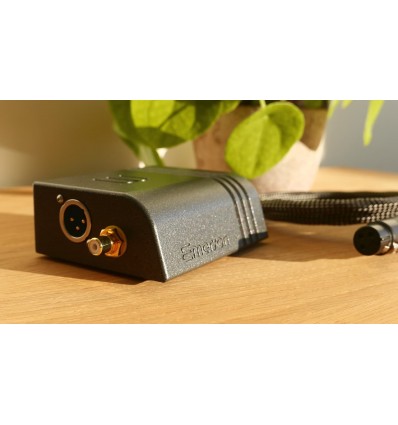Inga produkter
Produkt har lagts till din varukorg
Det finns 0 produkter i din varukorg. Det finns 1 produkt i din varukorg.
Nätverkspelare med riktigt stabil klocka och både 75 och 110 ohms digital utgång.
Tidal, Qobuz, Roon, airplay och egen app som fungerar.
Schweizisk kvalitét.
Finns för demo!
Inside technologies
The apparent simplicity of our streamers actually hides a complexity and a finesse far greater than it seems. From the choice of the internal components to the embedded software and circuit topologies, each step of the development process has been essential to enhance the listening experience.
Concept
Two different strategies have been used in our range of streamers.
The philosophy implemented in the Emerson is that of the straight wire: no sampling frequency conversion or data processing is applied, apart from volume control when used. The flow of data from the network interface is transmitted directly to the S/PDIF and AES/EBU modulators of the Emerson DIGITAL, or respectively to the digital-to-analog conversion chip in the case of the Emerson ANALOG. When properly implemented, this solution guarantees a transparent and coloration-free reproduciton.
The Madison features a more complex architecture as it incorporates a signal processing unit (DSP) that hosts our proprietary oversampling process for optimizing input signals. This new interpolation algorithm benefits from the heritage of the iconic modules developed by Anagram Technologies. It significantly improves the digital-to-analogue conversion process in the time domain, without modifying the samples of the incoming data stream.
Network interface
The Madison, as well as both Emerson models leverage Engineered's streaming engine, a proprietary solution based on a Sitara processor from Texas Instruments.
The embedded software, which handles the various network communication protocols and audio stream decoding, has been under continuous development for many years. Internal processes have been optimized to ensure audio data integrity, transmission reliability, support for Hi-Res file formats (PCM and DSD) without transcoding, and a smooth and responsive user experience at the same time.

Clocks
Two clock generators are used alternately, depending on whether the track being played back is sampled at a base frequency of 44.1kHz or 48kHz (as well as any multiples thereof). Our streamers do not include a variable oscillator or a synchronization loop. The stream of audio data is therefore directly cadenced by the active clock.
Additionally, the selected oscillators offer superlative performances, with extremely low phase noise in the audible bandwidth. The distribution of the clock signals has been carefully designed to minimize jitter throughout the digital audio signal path.

Output stages
The Emerson DIGITAL uses two separate modulators for the S/PDIF output and the AES/EBU output. This is the only way to meet the specifications of both standards without having to make compromises. High-speed output stages, synchronized by the main clock to avoid jitter, and two wide bande RF transformers ensure independent isolated outputs and a perfect rejection of common mode problems for superior performances.
For the Emerson ANALOG, a DAC from Cirrus Logic was chosen. This is a well-proven integrated circuit capable of impressive playback quality when optimally implemented. Its power supply, output stages topology and filter circuits required a lot of adjustments, measurements and listening before validating the final solution in accordance with the product philosophy.


Each channel of the Madison has its own separately powered, dual-differential digital-to-analog conversion chip. We chose the same Cirrus Logic DAC used in the Emerson ANALOG. The analogue filters are differential and calculated to minimise phase rotation while providing optimum attenuation of residual DAC switching noise. The output stages, based on the latest generation of operational amplifiers, are fully balanced and differential to achieve identical performance at both RCA and XLR outputs.
Power supply
The quality of the power supply for sensitive electronic circuits is a decisive factor for a device of this type. Once again, a close attention has been paid to the selection of the components and topologies. The choice of using an external adapter offers the advantage of keeping the mains voltage away from the core of the device. The DC voltage supplied by the external power adapter is smoothed by a series of common and differential mode filters and then delivered to the various components of the electronic board. Each critical section of the circuits benefits from a dedicated filtering and voltage regulator to avoid undesirable interactions. In the case of the Madison, no less than 15 low-noise voltage regulators ensure optimal operation of each critical section.
Finally, the power supplies for the clock generators, the synchronization circuits and the analog section are particularly well performing, with an extremely low electrical noise, less than 1µV RMS (measured in a frequency bandwidth from 10Hz to 100kHz).
Technical specifications
Key features
-
Proprietary streaming solution by engineered SA
-
Lossless LEEDH Processing volume control
-
Innovative and highly performing clock circuit and synchronization system
-
Ultra-low phase noise oscillators, < -135dBc/SQ(Hz) at 100Hz and < 50fs RMS jitter
Connectivity
-
Network input: Ethernet 100 Mbit/s
-
Outputs: 1x S/PDIF on RCA connector and 1x AES/EBU on XLR connector
Restitution
-
Supported compression formats: WAV, FLAC, AIFF, ALAC, MP3, AAC, Ogg Vorbis, WMA
-
PCM up to 24-bit 192kHz
-
Control protocols: UPnP/DLNA, AirPlay compatibility, Roon Ready
-
Streaming services brought by the Wattson Music app:TIDAL¹, Qobuz², airable radios
Performances
-
S/PDIF output: 75 ohms, with isolation transformer
-
AES/EBU output: 110 ohms, with isolation transformer
-
Very low noise power supply (< 1µV RMS 10Hz-100kHz)
Mechanical and electrical characteristics
-
Dimensions (W x D x H): 4,1 x 3,4 x 1,5in (104 x 87 x 38mm)
-
Weight: 0,82lb (371g)
-
Power supply: 5V DC, external, medical grade
-
Power consumption: 1,5W (idle), 2,5W (playing)
Packaging
-
FSC cardboard 1,64oz/sq ft (500g/m²)





